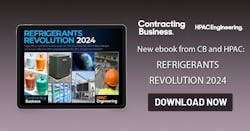eBook: Refrigerants Revolution 2024
In December 2020, at the height of the Coronavirus pandemic, Congress passed the bipartisan American Innovation and Manufacturing (AIM) Act. The new law set in motion an aggressive timetable for the Environmental Protection Agency (EPA) to address harmful hydrofluorocarbons (HFCs) by phasing down their production and consumption nationwide, promoting the development of substitutes and facilitating the transition to next-generation technologies.
The goal of the phasedown is to reduce the availability of high Global Warming Potential (GWP) refrigerants and accelerate the reductions of Carbon Dioxide equivalent (CO2e) emissions at a national level.
Essentially, the law authorized EPA on January 1, 2022, to initiate a high-GWP refrigerant phasedown schedule. Arguably, the most significant early date on that new schedule is January 1, 2024, when the total quantity of allowed HFC production and consumption must drop another 30%, moving the target to the 60% level of the historic baseline. And five years later, this will be followed again in 2029 with another 30% baseline reduction.
Needless to say, the accelerated pace of this schedule has caused significant disruption in our industry, not to mention several legal challenges and growing concerns over a potential influx of illegal refrigerant substitutes. But the train has left the station. The EPA phasedown schedule is now fixed, so no one should plan on these reduction levels being delayed or halted. That means we can expect further significant market disruptions in 2024 and in the years to come.
Among the major developments already underway in the HFC phasedown is the adoption of multiple alternatives, most notably A2L (mildly flammable) refrigerants, which require certain precautions by technicians and distributors.
With all that in mind, this eBook aims to help contractors and engineers to navigate the anxious days ahead in this unprecedented transition.
